Comcast 2014 Annual Report Download - page 31
Download and view the complete annual report
Please find page 31 of the 2014 Comcast annual report below. You can navigate through the pages in the report by either clicking on the pages listed below, or by using the keyword search tool below to find specific information within the annual report.-
 1
1 -
 2
2 -
 3
3 -
 4
4 -
 5
5 -
 6
6 -
 7
7 -
 8
8 -
 9
9 -
 10
10 -
 11
11 -
 12
12 -
 13
13 -
 14
14 -
 15
15 -
 16
16 -
 17
17 -
 18
18 -
 19
19 -
 20
20 -
 21
21 -
 22
22 -
 23
23 -
 24
24 -
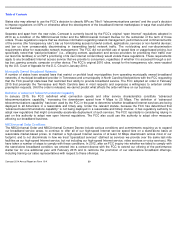 25
25 -
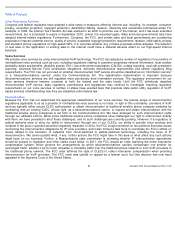 26
26 -
 27
27 -
 28
28 -
 29
29 -
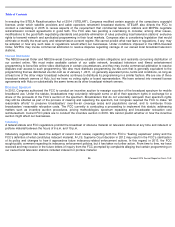 30
30 -
 31
31 -
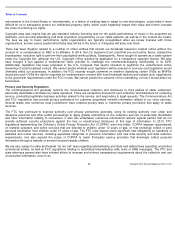 32
32 -
 33
33 -
 34
34 -
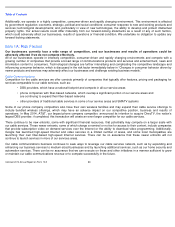 35
35 -
 36
36 -
 37
37 -
 38
38 -
 39
39 -
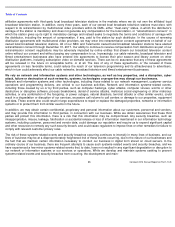 40
40 -
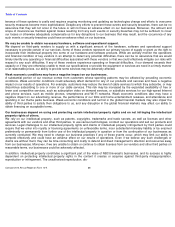 41
41 -
 42
42 -
 43
43 -
 44
44 -
 45
45 -
 46
46 -
 47
47 -
 48
48 -
 49
49 -
 50
50 -
 51
51 -
 52
52 -
 53
53 -
 54
54 -
 55
55 -
 56
56 -
 57
57 -
 58
58 -
 59
59 -
 60
60 -
 61
61 -
 62
62 -
 63
63 -
 64
64 -
 65
65 -
 66
66 -
 67
67 -
 68
68 -
 69
69 -
 70
70 -
 71
71 -
 72
72 -
 73
73 -
 74
74 -
 75
75 -
 76
76 -
 77
77 -
 78
78 -
 79
79 -
 80
80 -
 81
81 -
 82
82 -
 83
83 -
 84
84 -
 85
85 -
 86
86 -
 87
87 -
 88
88 -
 89
89 -
 90
90 -
 91
91 -
 92
92 -
 93
93 -
 94
94 -
 95
95 -
 96
96 -
 97
97 -
 98
98 -
 99
99 -
 100
100 -
 101
101 -
 102
102 -
 103
103 -
 104
104 -
 105
105 -
 106
106 -
 107
107 -
 108
108 -
 109
109 -
 110
110 -
 111
111 -
 112
112 -
 113
113 -
 114
114 -
 115
115 -
 116
116 -
 117
117 -
 118
118 -
 119
119 -
 120
120 -
 121
121 -
 122
122 -
 123
123 -
 124
124 -
 125
125 -
 126
126 -
 127
127 -
 128
128 -
 129
129 -
 130
130 -
 131
131 -
 132
132 -
 133
133 -
 134
134 -
 135
135 -
 136
136 -
 137
137 -
 138
138 -
 139
139 -
 140
140 -
 141
141 -
 142
142 -
 143
143 -
 144
144 -
 145
145 -
 146
146 -
 147
147 -
 148
148 -
 149
149 -
 150
150 -
 151
151 -
 152
152 -
 153
153 -
 154
154 -
 155
155 -
 156
156 -
 157
157 -
 158
158 -
 159
159 -
 160
160 -
 161
161 -
 162
162 -
 163
163 -
 164
164 -
 165
165 -
 166
166 -
 167
167 -
 168
168 -
 169
169 -
 170
170 -
 171
171 -
 172
172 -
 173
173 -
 174
174 -
 175
175 -
 176
176 -
 177
177 -
 178
178 -
 179
179 -
 180
180 -
 181
181 -
 182
182 -
 183
183 -
 184
184 -
 185
185 -
 186
186 -
 187
187 -
 188
188 -
 189
189 -
 190
190 -
 191
191 -
 192
192 -
 193
193 -
 194
194 -
 195
195 -
 196
196 -
 197
197 -
 198
198 -
 199
199 -
 200
200 -
 201
201 -
 202
202 -
 203
203 -
 204
204 -
 205
205 -
 206
206 -
 207
207 -
 208
208 -
 209
209 -
 210
210 -
 211
211 -
 212
212 -
 213
213 -
 214
214 -
 215
215 -
 216
216 -
 217
217 -
 218
218 -
 219
219 -
 220
220 -
 221
221 -
 222
222 -
 223
223 -
 224
224 -
 225
225 -
 226
226 -
 227
227 -
 228
228 -
 229
229 -
 230
230 -
 231
231 -
 232
232 -
 233
233 -
 234
234 -
 235
235 -
 236
236 -
 237
237 -
 238
238 -
 239
239 -
 240
240 -
 241
241 -
 242
242 -
 243
243 -
 244
244 -
 245
245 -
 246
246 -
 247
247 -
 248
248 -
 249
249 -
 250
250 -
 251
251 -
 252
252 -
 253
253 -
 254
254 -
 255
255 -
 256
256 -
 257
257 -
 258
258 -
 259
259 -
 260
260 -
 261
261 -
 262
262 -
 263
263 -
 264
264 -
 265
265 -
 266
266 -
 267
267 -
 268
268 -
 269
269 -
 270
270 -
 271
271 -
 272
272 -
 273
273 -
 274
274 -
 275
275 -
 276
276 -
 277
277 -
 278
278 -
 279
279 -
 280
280 -
 281
281 -
 282
282 -
 283
283 -
 284
284 -
 285
285 -
 286
286 -
 287
287 -
 288
288 -
 289
289 -
 290
290 -
 291
291 -
 292
292 -
 293
293 -
 294
294 -
 295
295 -
 296
296 -
 297
297 -
 298
298 -
 299
299 -
 300
300 -
 301
301 -
 302
302 -
 303
303 -
 304
304 -
 305
305 -
 306
306 -
 307
307 -
 308
308 -
 309
309 -
 310
310 -
 311
311 -
 312
312 -
 313
313 -
 314
314 -
 315
315 -
 316
316 -
 317
317 -
 318
318 -
 319
319 -
 320
320 -
 321
321 -
 322
322 -
 323
323 -
 324
324 -
 325
325 -
 326
326 -
 327
327 -
 328
328 -
 329
329 -
 330
330 -
 331
331 -
 332
332 -
 333
333 -
 334
334 -
 335
335 -
 336
336 -
 337
337 -
 338
338 -
 339
339 -
 340
340 -
 341
341 -
 342
342 -
 343
343 -
 344
344 -
 345
345 -
 346
346 -
 347
347 -
 348
348 -
 349
349 -
 350
350 -
 351
351 -
 352
352 -
 353
353 -
 354
354 -
 355
355 -
 356
356 -
 357
357 -
 358
358 -
 359
359 -
 360
360 -
 361
361 -
 362
362 -
 363
363 -
 364
364 -
 365
365 -
 366
366 -
 367
367 -
 368
368 -
 369
369 -
 370
370 -
 371
371 -
 372
372 -
 373
373 -
 374
374 -
 375
375 -
 376
376 -
 377
377 -
 378
378 -
 379
379 -
 380
380 -
 381
381 -
 382
382 -
 383
383 -
 384
384 -
 385
385 -
 386
386
 |
 |

Table of Contents
International Regulation
International regulation of television broadcasting varies widely according to jurisdiction and includes the regulation of programming
and advertising. For example, the European Union (“E.U.”)
establishes minimum levels of regulation across all E.U. member states
focused on content and advertising, which also extends to nonlinear television services, although E.U. countries are free to impose
stricter regulation in certain areas.
Online Video Distributors
The FCC has initiated a rulemaking to consider classifying certain OVDs that offer multiple linear programming networks to
customers with a broadband Internet connection as MVPDs under FCC rules. The FCC’
s proposal is designed to ensure that these
OVDs have program access rights to programming from vertically integrated cable programmers and the right to force broadcast
stations to negotiate to license their content. The FCC also has proposed potentially excusing these entities from all or some of the
regulatory obligations applicable to current MVPDs. If adopted, these proposals would increase our program access obligations and
raise complicated issues regarding the licensing of our broadcast programming. The outcome of this proceeding cannot be
determined at this time.
Filmed Entertainment
Our filmed entertainment business is subject to the provisions of “trade practice laws”
in effect in 25 states and Puerto Rico relating
to theatrical distribution of motion pictures. Under various consent judgments, federal and state antitrust laws and state unfair
competition laws, motion picture companies are subject to certain restrictions on trade practices in the United States. In countries
outside the United States, there are a variety of existing or contemplated governmental laws and regulations that may affect our
ability to distribute and license motion picture and television products, as well as consumer merchandise products. The ability of
countries to deny market access or refuse national treatment to products originating outside their territories is regulated under
various international agreements.
Theme Parks
Our theme parks are subject to various regulations, including laws and regulations regarding environmental protection, privacy and
data protection, consumer product safety and theme park operations, such as health, sanitation, safety and fire standards, and
liquor licenses.
Other Areas of Regulation
Intellectual Property
Copyright, trademark, unfair competition, patent, trade secret and Internet/domain laws of the United States and other countries
help protect our intellectual property rights. In particular, piracy of programming and films through unauthorized distribution of
counterfeit DVDs, peer-to-
peer file sharing and other platforms presents challenges for our cable networks, broadcast television
and filmed entertainment businesses. The unauthorized reproduction, distribution or display of copyrighted material over the
Internet or through other methods of distribution, such as through devices, software or websites that allow the reproduction,
viewing, sharing and/or downloading of content by either ignoring or interfering with the content’
s security features and copyrighted
status, interferes with the market for copyrighted works and disrupts our ability to exploit our content. The extent of copyright
protection and the use of technological protections, such as encryption, are controversial. Modifications to existing laws that
weaken these protections could have an adverse effect on our ability to license and sell our programming.
While many legal protections exist to combat piracy, laws in the United States and internationally continue to evolve, as do
technologies used to evade these laws. We have actively engaged in the enforcement of our intellectual property rights and likely
will continue to expend substantial resources to protect our content. The repeal of laws intended to combat piracy and protect
intellectual property or weakening of such laws or
Comcast 2014 Annual Report on Form 10
-
K
26
